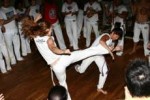Capoeira kicks culture into U.S. gyms

It might not be the most popular martial-art-turned-fitness-routine, but Capoeira, long a staple of New York City gyms, is gaining ground in the United States.
Capoeira is a form of martial arts that combines singing, dancing and music. Slaves practiced Capoeira in the early 19th century in Brazil to the chagrin of their owners. Europeans first documented Capoeira when they arrived at the shores of Rio de Janeiro in the early 1800s, according to The Hidden History of Capoeira.
“The Capoeira game” or “Black Capoeiras” as it was called by police records of the time, was a war-like game in which opponents tried to knock each other down while doing cartwheels and dancing around one another.
The game was considered violent by the Brazilian government, which linked it to the incitement of many riots. In response to such uproar, local authorities banned the game.
After the ban, Capoeira became associated with gangs and street fighters.
Frustrated with its aggressive reputation, Portuguese master and long-time practitioner Mestre Bimba decided to legitimize the art and make it a sport in the 1930s. He introduced the competitive elements of other martial arts like belts (or cords) to signify status. He also emphasized the Capoeira art form by adding acrobatics.
Bimba’s style came to be known as Capoeira Regional.
Concerned that the sport was losing its tradition, Mestre Pastinha, who opened the first Capoeira training school in 1942 in Brazil, named his more traditional style Capoeira Angola to emphasize the difference between the two arts.
Angola is distinctively closer to the ground than other traditions. Angoleros play in a bent position and more frequently make moves by placing their hands on the ground. Angola allows opponents to use sneakier tactics because players are closer to the ground and to each other, making it more difficult for them to see the opponent’s movements. It may be perceived as slower than Regional, because it lacks the same fast-paced acrobatics. Regional, for instance, has a lot of “jumping” attacks.
Angola instructor Jonathan Bloch came to USF last year to pursue a master’s degree in environmental science. With no Angola club nearby, he decided to form the Capoeira Angola Club on campus in February.
While Bloch said he respects Regional, he doesn’t believe that it’s for him. Bloch said Angola is more rooted in the tradition of Capoeira.
“(Regional) is a little more showy,” he said. “I find it a little bit too fast for me.”
Bloch said his preference for the Angola tradition also comes from the fact that it’s more difficult than others to work your way toward the top.
“For Capoeira Angola, there’s about 10 mestres around the world,” he said.
However, Bloch said his passion for the sport overrides his competitive drive.
“There’s really no winning or losing. We don’t need belts at Capoeira Angola. Just watch someone for two minutes and you can see where they are in their game,” he said.
In addition to the two established divisions of Capoeira, a newer form is gaining interest among college students.
Capoeira Contemporanea incorporates elements of both Angola and Regional. Its fast-paced style is attracting newcomers to the sport in gyms across the United States.
Hollywood helped spark additional interest in Capoeira with the sport’s role in movies such as Ocean’s 12, Catwoman and Meet the Fockers, in which characters learn to balance self-control and flexibility with the sport’s demanding moves.
As the sport increases in popularity, Capoeira players debate whether the art form is evolving or being destroyed as it strays from its original practices. Regardless, young people are spreading interest in the Capoeira tradition by embracing its athletic culture.
“We’re very, very involved. It’s our lifestyle. It should be part of your life,” Bloch said.
Students who want to join the USF Capoeira Angola Club can contact Bloch at 510 417-0205.
For locals interested in learning more about Capoeira, visit tampacapoeira.com.






